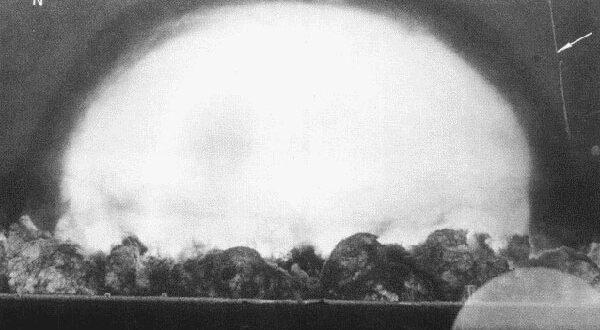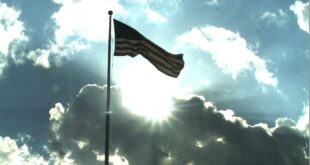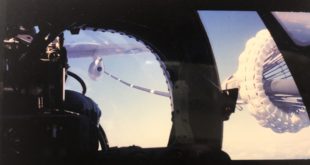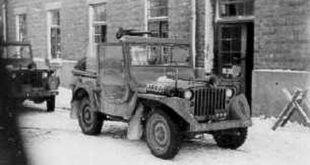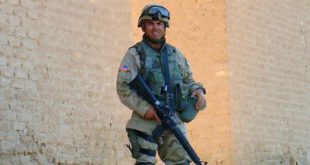Summer moviegoers who are curious how the world became so dangerous might consider Hollywood’s big-screen depiction of the first A-bomb test in the new film Oppenheimer. A good portion of this movie is set at Trinity Site, a restricted area in New Mexico’s high desert. In his nonfiction book Plow the Dirt but Watch the Sky: True Tales of Manure, Media, Militaries, and More, author Martin Kufus, a former Soldier of Fortune magazine editor (1995–97), describes Trinity Site and the reminders there of the world’s first atomic blast. The following is an excerpt from his chapter, “T is for Trinity.”
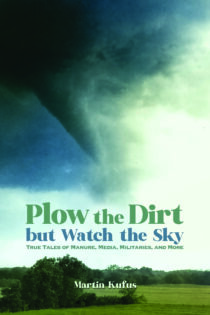
T is for Trinity
Minutes before dawn on July 16, 1945, a blinding man-made sun rose terrifyingly about 27 miles from San Antonio, New Mexico, a small, Rio Grande town south of Albuquerque. Locals had known for months that something unusual was taking place out on vast ranchlands the Army had appropriated beyond the rough hills ascending to Jornada del Muerto: south-central New Mexico’s “journey of the dead man.” Exactly what was going on southeast of San Antonio was hush-hush—there was a war on.
“The day it happened,” the cashier at San Antonio’s Owl Bar and Café said in 2015, “my great-grandmother thought it was the end of the world. She put the children under the bed!” The world did not end at 5:29 a.m., but it was forever changed. The atomic age had arrived.
Scientists calculated the world’s first atomic bomb exploded with the equivalence of 20 kilotons—40 million pounds—of TNT. “The heat was like opening up an oven door, even at 10 miles,” a military policeman (MP) at the base camp remarked, according to an Army public-affairs booklet, Trinity Site—July 16, 1945. The A-bomb project’s director, Army Maj. Gen. Leslie Groves (an engineer and blunt-spoken bear of a man) had ordered up a cover story. “Although no information on the test was released until after the atomic bomb was used as a weapon against Japan, people in New Mexico knew something had happened,” the booklet says. “The shock wave broke windows 120 miles away and was felt by many at least 160 miles away. Army officials simply stated that a munitions storage area had accidently exploded at the Alamogordo Bombing Range.”
READ MORE from Martin Kufus: ‘G’ is For Gonzo
San Antonio had few businesses back then. One was the Owl Bar. Local son Frank Chavez opened it in 1945 after returning from WWII duty in the Navy. He and his wife Dee started frying hamburgers (according to the Owl’s history) for an influx of customers who said they were “prospectors.” One of them was almost certainly a skinny man with piercing eyes under a trademark pork-pie hat. Born in New York City to affluent German–Jewish parents, J. Robert Oppenheimer had been educated in physics on both sides of the Atlantic. However, he had fallen in love with New Mexico as a teenager riding horses and camping on a dude ranch (according to the Pulitzer-winning, 2005 biography American Prometheus: The Triumph and Tragedy of J. Robert Oppenheimer). Now, the charismatic Oppenheimer was the intellectual nucleus of a national crash program that had been undertaken to create a superweapon before Nazi Germany and use it on the Third Reich. …
These “prospectors” and military officers and MPs never let slip what was coming. It arrived at the base camp southeast of San Antonio as the bulky, plutonium-cored device built at the super-secret laboratory at Los Alamos, some 160 miles to the north. The 5,000-pound “gadget” would perch 100 feet above Trinity sands on a steel tower to approximate a wartime aerial burst.
In a 1939 letter to President Franklin D. Roosevelt, expatriate German physicist Albert Einstein had warned of the theoretical possibility of “a nuclear chain reaction in a large mass of uranium” in a bomb. Einstein had left Germany in 1932, just before the Jew-hating Adolf Hitler became chancellor. The world-famous physicist hinted strongly at Germany’s interest in this field. The Manhattan Project began in June 1942; by 1945, however, the winds of war had shifted. A vengeful Red Army roared westward into Germany from the invasion-ravaged USSR. American-led allied forces pushed eastward from formerly occupied France. (Germany’s A-bomb program, it would be discovered, never had gotten very far.) But, imperial Japan still fought. The 82-day Allied amphibious invasion of nearby Okinawa produced staggering numbers of casualties among invaders, defenders, and civilians. An invasion of the Japanese homeland would have been far worse.
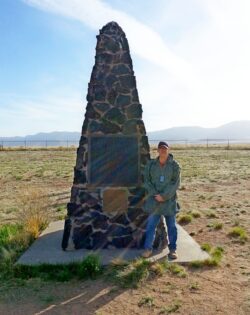
Author Kufus at ground zero for the Trinity site, 2015
After Trinity Site’s success, the Army, with the Navy’s help, hurriedly transported two atomic weapons and technical staff across the Pacific Ocean. Japanese cities Hiroshima and Nagasaki were on early August target lists for the uranium-gun-type “Little Boy” and plutonium-implosion “Fat Man” bombs, respectively, carried by Army B-29 Superfortresses flying from an island base. President Harry Truman, historians have speculated, also calculated the A-bombs would discourage Communist dictator Josef Stalin from any Soviet move on Japan. In terms of immense costs, cutting-edge science and engineering, nationwide research and industrial support, and—like it or not—national prestige, the Manhattan Project has been compared to the NASA Apollo program of two decades later. (And, to that end, 67 captured Nazi V-2 ballistic missiles were modified and test-launched high over New Mexico’s White Sands region beginning in May 1946.)
It was minutes before noon on April 4, 2015. … The Owl Café and Saloon was busy; a line of customers almost was out the front doors. … WSMR’s Stallion Gate is about a 17-mile drive east of San Antonio, mostly on US 380. The gate had opened to the public at 8 a.m., for six hours. At 6:45 a.m., there were 20 vehicles outside the locked gate. At opening, the line stretched a mile or more; by 11 a.m., the line of vehicles was about four miles long. A dozen or more people with handmade signs stood or sat in camping chairs a respectful distance from Stallion Gate: Members of the ‘Tularosa Basin Downwinders’ invited visitors to stop and talk about their as-yet unresolved claim the 1945 blast’s radioactive plume had harmed generations of family and friends.
After clearing the gate’s armed guards, “atomic tourists” drove past a WSMR missile-launch-observation compound—no stopping or photos allowed—and south–southeast on a 17-mile range road to a large parking area and series of chain-linked fences. Anybody expecting a museum or theme park would be disappointed: Trinity is a special place where the more knowledge a visitor brings, the greater the experience. In fact, the largest object there—beside and inside of which many atomic tourists have posed for snapshots—actually did little in 1945.
Cylindrical “Jumbo,” originally a 214-ton steel container measuring 25 feet in length and 10 feet in diameter, was built to hold an A-bomb misfire. Los Alamos scientists initially feared the conventional explosives encasing the plutonium core might not create and sustain a nuclear chain reaction; that the explosion would scatter the precious and dangerous plutonium—post-9/11, we’d call it a “dirty bomb”—and so Jumbo would contain it all or be vaporized in a successful atomic blast. However, the scientists became more confident and Jumbo was parked 800 yards away. Nowadays, it sits near the entrance to the nearly quarter-mile walk to ground zero.
In that fenced-in, circular area hundreds of feet across stands a stone-and-mortar obelisk with bronze plaques; almost all atomic tourists pose beside it for photos. A few feet away is—amazingly—a remnant of the original concrete-and-metal footing of the 100-foot tower. … Many of the atomic tourists strolling across ground zero did so with heads bowed; maybe pondering the enormity of this grim history but, more likely, looking underfoot for a little sparkle of green. The nuclear energy released here in 1945 melted sand on the ground but also sucked it high into the superheated air; it fell to earth as drops of colored liquid, coalescing into a new substance: Trinitite. Decades ago, Atomic Energy Commission crews filled in much of the blast’s depression and hauled away most, but not all, of the Trinitite. It now is illegal to remove any from the national landmark (where radioactivity levels are almost normal). … In 2004, Los Alamos scientists reinvestigated its formation, according to the Trinity Site booklet. From that, they calculated the 1945 fireball’s temperature at 14,710° F.
Another must-see is about 3 miles away by military shuttle buses: the vacated McDonald Ranch House. Abandoned by its owners in 1942 when the Army took over the area for a bombing and gunnery range, the house was vacant until early 1945. Then, it was taken over by the Army as a support site for Trinity. The house’s master bedroom—small by contemporary standards for a “master bedroom”—was converted to a clean room for assembly of the A-bomb’s high-explosive and plutonium core. Although only two miles straight-line distance from the blast, the most significant damage was to the house’s windows that were blown out. …
Most Trinity Site visitors probably overlook what remains of the “West 800 Instrumentation Shelter,” the reinforced bunker that sheltered cameras and radiation-measuring instruments. The cameras occupied lead-lined boxes (shielding film against ruinous gamma rays) on the back side of the bunker and received imagery via a series of mirrors. The boxes had been attached to sleds to be pulled safely out of the “hot zone” with cables. From the West 800 bunker came one of the most striking black-and-white photographs of the 20th century: the atomic blast, as a malevolent hemisphere caught at 16 milliseconds, rising hundreds of feet above the high desert—as filmed by super high-speed movie cameras at an astonishingly close 800 yards …
And, to think this superweapon was created when the few existing electronic computers used vacuum tubes, were very slow by contemporary standards, and occupied whole rooms; when equations were written out on chalkboards and calculations were made with slide rules.
Plow the Dirt But Watch the Sky is available on Amazon and at other retailers.
Watch the film trailer, below.
 Soldier of Fortune Magazine The Journal of Professional Adventurers
Soldier of Fortune Magazine The Journal of Professional Adventurers


